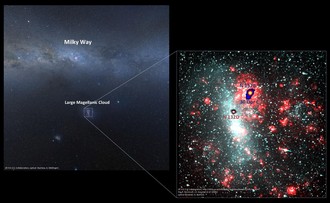 H.E.S.S.discovers three extremely luminous gamma-‐ray sources in Milky Way’s satellite galaxy.
H.E.S.S.discovers three extremely luminous gamma-‐ray sources in Milky Way’s satellite galaxy.
Once again, the High Energy Stereoscopic System, H.E.S.S., has demonstrated its excellent capabilities. In the Large Magellanic Cloud, it discovered the most luminous very high-‐energy gamma-‐ray sources: three objects of different type, namely the most powerful pulsar wind nebula, the most powerful supernova remnant, and a shell of 270 light years in diameter blown by multiple stars, and supernovae – a so called superbubble. This is the first time that stellar-‐type gamma-‐ray sources are detected in an external galaxy, at these gamma-‐ray energies. The superbubble represents a new source class in very high-‐energy gamma
rays.
The results are published in: "The exceptionally powerful TeV γ-ray emitters in the Large Magellanic Cloud", H.E.S.S. Collaboration, Science 347, 406 (2015). Co-authors are astrophysicists from the Copernicus Astronomical Center: dr hab. Jarosław Dyks, mgr Mateusz Janiak, prof. dr hab. Włodzimierz Kluźniak, dr hab. Rafał Moderski, prof. dr hab. Bronisław Rudak, prof. dr hab. Andrzej Zdziarski.
Figure: Optical image of the Milky Way and a multi-‐wavelength (optical, Hα) zoom into the Large Magellanic Cloud with superimposed H.E.S.S. sky maps. (Milky Way image: © H.E.S.S. Collaboration, optical: SkyView, A. Mellinger; LMC image: © H.E.S.S. Collaboration, http://dirty.as.arizona.edu/~kgordon/research/mc/mc.html, Hα: R. Kennicutt, J.E. Gaustad et al. (2001), optical (B-‐band): G. Bothun).






